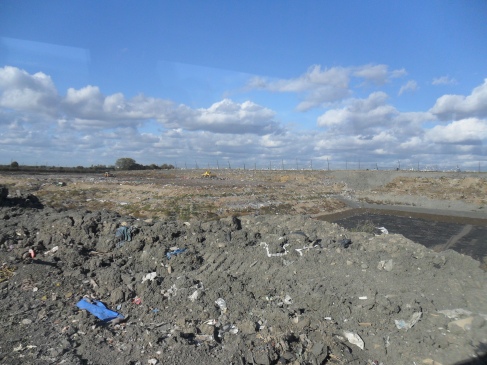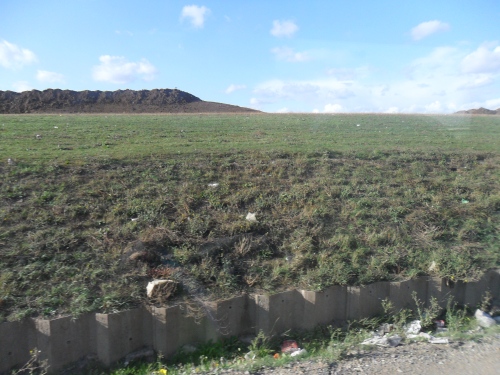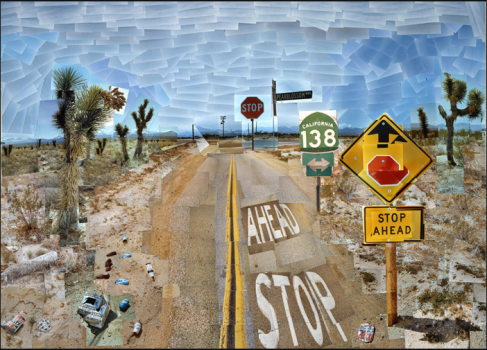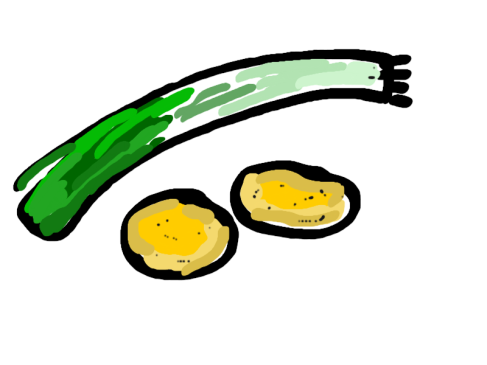I was privileged enough to visit a landfill site last year in Cambridgeshire – I say privileged because it was extremely interesting. I always try to be mindful of what I put in the rubbish bin because by filling a landfill site we are effectively burying pollutants (rubbish) into the ground, and the less we do so of this, the better. The problem with landfills is that they always leach. Commonly, rainwater seeps through the layers of rubbish which rapidly becomes contaminated with whatever chemicals/foods etc are decomposing in the landfill. This sludge is known as leachate, and it accumulates at the bottom of the landfill pit, where it slowly seeps into the soil where it can then contaminate soil or groundwater (groundwater is water which is under the Earth’s surface; sometimes humans use it for drinking, but groundwater can also join up with freshwater bodies, such as rivers and lakes). Either way, it is a problem, because the environment is becoming polluted – whether it’s the soil that we grow our crops on, or the rivers that we swim in. In my opinion, simply dumping rubbish in a very large hole is a very primitive form of waste management – and one that probably hasn’t changed since civilization began!
I don’t think that incinerating our rubbish instead of burying is a good solution. Burning plastics releases a multitude of harmful gases into the atmosphere.

Above, the landfill site as viewed from the coach (we were given a tour guide). I hope this photo gives you some idea of the immensity of the landfill site – in the distance you can see a yellow rubbish lorry emptying out household rubbish. The sad thing was that one of these lorries would arrive on the site every minute. They would dump black plastic bags straight onto the top of the ‘hill’ that they were creating that is full of rubbish. As you can see, the site is littered with rubbish – it was a particularly windy day. Our tour guide told us that the workers regularly have to organise litter cleanups to collect the litter. Still, it would be impossible to collect it all- a lot of it (lightweight plastics particularly, such as plastic bags) would be blown off the site into our cities, towns and the countryside.

Above, the lining of the landfill site. The pit is lined with clay (light grey) and tyres (dark grey) – but leaching still occurs. Leaching is inevitable, despite precautions (clay & tyres).

Above, a closeup of the mounds of tyres (dark grey).

Above, a particularly striking photo of the landfill site – trucks emptying their load. If you look closely you may be able to see lightweight rubbish (paper, plastic bags), flying up into the air…

Eventually, landfill sites do fill up, as seen by the photo above (the site I visited in Cambridgeshire is expected to close within a decade). The landfill is sealed with clay, and soil is added so that grassland can grow. The grassland needs to be carefully managed, to prevent trees/bushes from growing. This is because their roots can penetrate into the rubbish of the landfill, allowing the gases that are accumulating underground to escape. Such gases include methane (a greenhouse gas that is more potent than carbon dioxide! Methane is emitted by rotting food. Interestingly, the UK is a world leader in capturing methane that is emitted from landfill sites and using it to generate electricity. However, after 10-15 years a landfill site will stop emitting methane since all the food has rotted away, so there’s only so much free electricity you can get from this system).

Above, a photo to show what happens to the green waste that is collected in the UK. It is dumped outdoors, where it rots to become a compost that the waste contractors can then sell.
So what is the solution to the nightmare of waste management? First and foremost, we need to look at the waste hierarchy, see diagram below.

The most favoured option is to prevent waste occurring in the first place. When it comes to plastic bags for example, they can simply be refused. Thus, by not using plastic bags, they are prevented from entering the waste stream. Alternatively, one could minimise plastic bag usage. More than often, people end up reusing their plastic bags e.g. by lining their bins with them (however, in this case you are only reusing them once, which isn’t ideal as it will end up in the landfill eventually). Alternatively, plastic bags can be recycled at specialist facilities (many major supermarkets in England collect them for recycling). Now recycling is not ideal for two reasons:
1) Recycling requires energy, and energy very often means that carbon dioxide emissions are pumped into the atmosphere (which causes global warming). Unless of course, your recycling plant is powered by solar/wind/other renewable energies.
2) Your recycling input must not be contaminated. Take the example of me putting a plastic bag in the glass recycling bin. The mixture is likely not to be sorted at the glass recycling facility (this would take too long and be costly- not to mention that having to manually sort through recycling is an unpleasant job) and as a consequence, the output of the glass recycling facility would be of poorer quality because it would be contaminated by plastic. If the contamination was particularly high, the output would not be able to be reused… and it would end up in landfill! This is why it is so important to sort your recyclables so thoroughly. That said though, it’s not an easy job because I don’t think there is enough information provided to consumers with regards to what is recyclable and what isn’t. It can all be very confusing.
Energy recovery is an interesting form of waste management which can be quite useful. For example, food waste can be sent to an anaerobic digestor (AD). An AD is a tank that contains bacteria which degrades food, and this process generates methane which can be used to generate electricity, as well as a fertilizer for crops. Once again, this must not be contaminated by other materials – the bacteria wouldn’t be able to degrade plastic, and it would end up clogging the tank.
Finally, the last resort in the waste hierarchy is disposal: burying rubbish under the ground. I think that this is a complete waste of resources – surely mankind with all of its ingenuity can efficiently use packaging so that it can be recycled or composted, so that we don’t have to pollute our precious land?

http://www.ameycespa.com/east/mbt
Above is a photo of a Mechanical and Biological Treatment plant (MBT). This is a series of conveyors and expensive machinery that attempts to segregate the recyclables from rubbish. This piece of equipment cost £42 million pounds, and it is effectively in place because the citizens cannot or will not recycle properly. As a consequence their rubbish is full of recyclables that can be reused, such as glass, metals, and even some plastics.
The MBT process:
1) The black plastic bin bags are shredded at the start of the process, spilling their contents on the conveyor belts – a smelly affair!
2) Recyclables such as metals are removed from the belt by magnets, glass is removed by weight and some plastics are also removed from this process. This is the mechanical process
3) The final sludge is a mixture of paper, cardboard, lightweight plastics and food waste. Water is added to this sludge and the mixture is deposited in a giant hall, where it will decompose and reduce in volume over a period of weeks. This is the biological process. The final result is a compost that is contaminated with plastic which is then disposed of in the landfill site.
So the whole point of this £42 million worth of machinery is to recover recyclables and simultaneously to reduce the volumes of waste entering the landfill. I thought it was sad that a county had to spend so much on separating waste when it could have been done at the source i.e. in people’s homes for so much cheaper. Additionally, this process does not recover paper and cardboard (which can be recycled) and food waste (which as previously mentioned, can be placed in an AD tank). MBT plants are not particularly common due to their hefty price tag, but it is sad to think that they exist at all- think of how much money could have been saved if it didn’t need to be built in the first place!
Are you passionate about recycling? Do we need to be more mindful of what we put in our bins? Is the hassle of segregating our waste in our homes worth it in terms of money that can be saved?
Read Full Post »






















